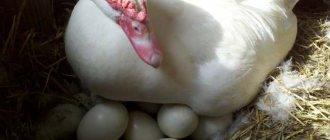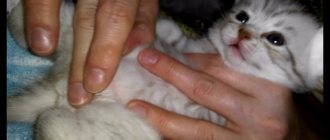14719Administration
3
A cat is a very soft and sweet pet that brings a huge amount of joy to every owner. But in addition to a lot of positive emotions, a funny little tiger can also cause a lot of trouble with its temporary problems. Any owner may be taken by surprise by the question of how many days a cat has been walking.
The animal may want to go free swimming due to the onset of puberty. Typically, in older individuals this process begins around the eighth month of life. This process depends on many factors:
- Breeds;
- Physique;
- Heredity;
- Living conditions;
- The presence of adults nearby.
At this time, the pet’s behavior may change dramatically; the cat becomes more active, aggressive and very persistently tries to leave the house. It's all due to hormones that force the beast to look for a “soul mate” for procreation. Not finding an outlet for its energy, a cat that is walking can spend it screaming incessantly day and night, attacking its owners and placing marks throughout the apartment. This means that the cat is ready for sexual intercourse.
To prevent this behavior, you can use special medications or resort to castration. But if you don’t like such methods, then you should stop at the simplest way to rid your cat of a hormonal storm and let him out for a walk. And here you need to know how often the cat walks.
© shutterstock
When can a cat be spayed?
When should a cat be spayed? Spaying a cat before her first heat reduces the risk of developing mammary tumors by up to 99.7%. A cat's first heat usually occurs between 6 and 8 months of age. That is, it is better to sterilize a cat at 6-7 months.
Interesting materials:
What should you not give to laying hens? What should you not give to Achatina snails? What should not be done after hirudotherapy? What should you not do with a headdress? What should you not do in medical school? What can't you do in a slow cooker? What cannot be sent by mail to Ukraine? What should you not do if you have intestinal colitis? What is neither right or wrong? Any morphological analysis?
How to let your cat go for a walk
As a rule, how long a cat spends walking is known very well by the owners of private houses, who do not absolutely need to castrate or sterilize their animals.
As a rule, several times a year the animals themselves leave home in search of a cat, and then return without any problems.
Residents of city apartments can also release an animal that is walking, but this is already accompanied by a number of difficulties. Due to the widespread use of intercoms, you will have to rely on the responsiveness of neighbors who will be able to recognize the cat and open the door for your pet.
Usually cats walk 2-3 times a year, in early spring and closer to winter. It is known that an animal that walks considers the place where it is fed to be its home, so it steadily returns to evening and morning feeding, and then again sets off on adventures.
The number of days that a cat will spend on a spree depends on how many ready-to-date cats come his way.
For some, a couple of days may be enough, while others may disappear for a week or two or not return at all, even when the cat goes for a walk for the first time. Unfortunately, animals left without the supervision of their owners become easy prey for dogs or fall under the wheels of cars.
© shutterstock
It is necessary to clearly monitor the state of the body of a walking cat, since a hormonal storm is very stressful for the animal . In his bowl, even if he walks and does not come home for several days, you need to keep fresh water and food. Perhaps your animal will suffer in a fight with other competitors, so you will have to heal torn ears or damaged eyes.
General information
City cats are deprived of this opportunity and walk around the apartment.
The concept of “walking” in cats is directly related to the search for a sexual partner. During this period, an apartment cat throws a significant tantrum to its owners, and cats from private homes simply go on adventures and search for like-minded people.
How often do cats go for walks?
The frequency of search depends on the estrus of each individual individual. Most often, estrus occurs in early spring and late autumn, but the general rhythm always depends on age, breed, personal hormonal levels and living conditions. The first heat occurs between 9 and 12 months, but always consider your pet's breed because the first heat can occur as early as 6 or 18 months.
During the first and subsequent heats, the behavior of the animal changes, this is especially noticeable if the cat is domestic, all the time in front of the eyes and during the rutting period, he begins to give concerts to the owners due to the lack of opportunity to throw out energy for its natural purpose.
Signs that your cat is ready to go for a walk:
- Aggression or excessive affection appears.
- Cats begin to mark their territory, and kitties pee more often.
- The pet meows almost non-stop, constantly trying to attract attention.
- The genitals swell and increased secretion appears.
- Appetite decreases.
- The gait changes, this is especially noticeable in females - they begin to lift their butts more and walk on tiptoes of their hind legs.
The immediate frequency depends on how effective the previous “hunt” was and how stable the hormonal levels are. In an adult male cat, if there has been sexual intercourse or even pregnancy, the energy has received an adequate release and the animal is satisfied - in such cases, estrus occurs according to a standard schedule 2-3 times a year.
But if estrus did not receive any logical conclusion, or the animal did not have enough sexual partners, pregnancy did not occur or was interrupted, then the schedule of festivities may become more frequent.
If your cat begins to go for walks frequently, but you are unable to independently identify the cause of the animal’s dissatisfaction, contact your veterinarian; your pet may have a hormonal imbalance.
IMPORTANT: after giving birth, a cat usually starts leaking again within 3-4 months, so you can’t compare her festivities schedule with the cats’ schedule.
How long does a cat walk?
How many days a cat walks depends not only on its personal insatiability, but also on its breed characteristics, whether there has been at least one intercourse at all. The fact of intercourse, however, affects mainly cats - after it, the female subsides after about 2-3 days, but the cat will look for partners until its hormonal release stops.
Examples of estrus duration in the most popular cat breeds:
- Maine Coon: the first heat occurs at the 12th month and passes quite calmly.
- Persians: a rune bird in the matter of puberty - at 6 months the owners will have their first concert. At the same time, the breed can conceive and bear offspring only after one and a half years.
- British breed: the first heat occurs every year and lasts from 4 to 14 days, depending on the characteristics of the body.
- Scottish Fold: It is not for nothing that breeders recommend castration if there is no goal of further breeding, because the breed walks 4 times a year starting from 10 months.
- Sphynxes: a difficult breed, because after the onset of a year, cats walk for a week once every 2 months. During this period, usually affectionate velor cats and seals turn into monsters, hissing and hating everything around them.
- Siamese breed: In general they are very similar to Sphynxes, with the only requirement that the first heat be at one and a half years.
How many days a cat walks for the first time often does not depend on the breed. Estrus lasts about a week, but all other times the period varies depending on the results of the rut.
Puberty of females
The correct name for estrus in females is estrus. This is a normal phenomenon, which indicates that your pet is in good health and that her body is ready for reproduction. Let's look at the signs by which you can recognize the onset of estrus.
How to understand that heat has begun
During estrus, the cat behaves in an unusual way. It is better for the owner to know the features of this period in advance so as not to harm the pet.
- At this time, the animal becomes more tactile and affectionate. Don't be surprised if it tries to climb onto your arms, rub against your limbs and follow you around.
- Some cats, on the contrary, show aggression and do not want to be held.
- To attract males, the female may secrete a few drops of urine and rub herself against accessible surfaces in the house.
- Another way to attract a cat’s attention is by meowing, which develops into incessant howls that are unpleasant to human hearing.
- The cat goes to the toilet more often and can sometimes ignore the tray, defecating in the wrong places.
- Your pet may give up her habits, such as regular play, following commands (if she is trained), and even eating.
- The female's genitals become swollen, but only a specialist can determine the onset of estrus based on this sign. A fluid that is invisible to humans is released from the genitals. The cat licks itself more often.
- The call of nature prompts the animal to run away in search of a mating partner. Therefore, if your pet is eager to go outside, it is most likely that she is in heat.
These signs may be present in total or appear to a minor extent. The experienced eye of the owner can determine the period of estrus by the atypical behavior of his animal. The most accurate way to understand that a cat is wandering is to take it to a veterinarian and undergo the necessary tests.
Estrus phases
There are four main phases of estrus. Observe your cat to better understand where she is in the process and determine if she is ready to mate.
- Proestrus. The beginning of a cycle that lasts up to four days. You can understand that an animal is going through this stage by a change in its mood: the female becomes playful, affectionate, and rolls around on the floor.
- Estrus. This is the active phase when the animal is ready for fertilization. Usually during this period, copious discharge from the genitals begins and the female invites the male with a loud meow. Estrus lasts up to 10 days.
- Metestrus. This phase lasts from 2 to 15 days, and its course depends on the characteristics of the body. If mating is successful, the active phase ends and after 58-72 days the cat will give birth to kittens. Sometimes a false pregnancy occurs, and for about a month the animal will behave as if fertilization has occurred. After 15 days, if there has been no fertilization, the female begins to show hostility towards males and soon returns to her usual behavior.
- Anestrus. The break time between heats can last from 3 weeks to 3 months. When choosing a cat breed, please note that the Siamese cat does not have this phase, and the estrus period can last up to 3 months. Read about what breed of cats to choose for your apartment in a separate article.
How often does heat occur?
The frequency and duration of the cycle depend on the genetic characteristics and living conditions of the pet.
Thus, animals living on the street quickly enter reproductive age and, while still very young (up to a year), can become pregnant. This is due to shorter life spans (survival) on the street. Therefore, if you take a street cat into your home, be prepared for the fact that her body will require mating more often. During the cold season, such cats rarely mate.
A domesticated and purebred pet that is protected from cold winters and has access to food can mate all year round. Temperamental cats with bright personalities may feel the need to breed every three weeks. Calmer breeds, such as Britons, are less sexually active and come into heat every three months.
If a cat has given birth, her body needs time to recover. When the period of nursing kittens ends (it takes about three months), the female will again strive to mate. If kittens are weaned or stillborn, estrus may begin 1-2 weeks after birth.
Cats that have given birth mate less frequently - once every 2-3 months. Nuliparous women can mate every month.
I found an interesting video where veterinarians talk in more detail about the cat's reproductive cycle and its duration. I recommend watching:
Age-related features of estrus
Puberty in cats occurs at 8-10 months of life, but it happens that estrus in females begins earlier. If your pet is more than a year old and this period has not yet occurred, immediately take him to the veterinarian to rule out the presence of pathologies.
The first heat may be accompanied by minor or barely noticeable signs, so the owner may not notice it. Some sources claim that after eight years of life such signs may also be subtle.
Cats do not have menopause. An animal can reproduce even in old age; the only question is whether its health will allow it to bear and give birth to viable offspring.
Puberty of males
The development of males differs slightly from the puberty of females. By 8-10 months of life, sperm mature and testicles descend. If this does not happen, contact your veterinarian. Some experts argue that in oriental breeds, for example, Siamese cats, puberty can begin earlier - at 5 months.
Males are ready to mate all year round; they do not have specific cycles.
How to understand that a cat has entered reproductive age
You can recognize the onset of puberty by changes in your pet's behavior.
- The animal begins to howl invitingly, attracting the attention of the opposite sex.
- The docile nature gives way to aggression and wariness towards other animals.
- The cat begins to mark its territory.
- Urine acquires a sharp, unpleasant odor.
- The cat can show attention to females and care for them.










